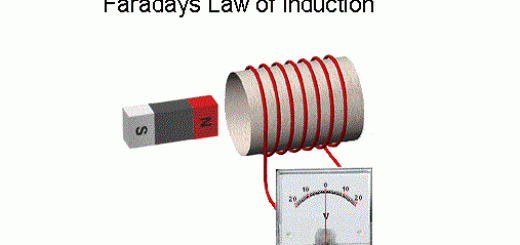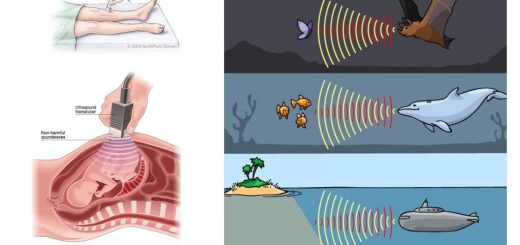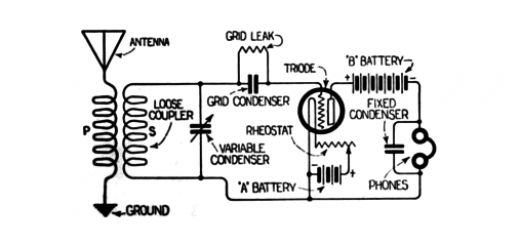Audible sounds, Doppler’s effect, Savart’s wheel importance, Sound properties and velocity
Sound is an external factor (or stimulus) that affects the ear causing the sense of hearing. Sound is produced due to the vibration of bodies and it stops when they stop vibrating the vibrating bodies stop their vibration. The difference in frequency between the tone (note) and noise because musical note (tone) is of uniform frequency, while noise is of non-uniform frequency.
Nature of sounds waves
Sounds waves are mechanical longitudinal waves. They are mechanical waves because they need a medium (as air) to propagate through. They are longitudinal waves because the medium particles vibrate in the same direction of wave propagation forming compressions and rarefactions. Sound waves propagate through media as spheres of compressions and rarefactions, whose center is the source of the sound.
We hear sound from all directions that surround the sound source because the sound travels through the air as spheres of compressions and rarefactions, whose center is the source of the sound. When the wavelength of a sound wave is 1.5 m. This means that the distance between the centers of two successive compressions or two successive rarefactions in such waves is 1.5 m.
Sound velocity
Sound travels through air at a velocity of 340 m/sec (It may exceed or become less than this value). Sound velocity can be calculated by using waves propagation law as follows:
Sound wave velocity (V) (metre/second) = Frequency (F) × Wavelength (λ)
The velocity of sound through air depends on the temperature of the air and the humidity of the air. The guardian dog puts its ears on the ground when it sleeps at night because the sound velocity through solids (the ground) is larger than that through the air.
Audible sounds
Sounds heard by the human ears are classified into two types, which are: Musical tones and noises. Musical tones are tones of uniform frequency and comfortable to be heard. Example: Violin, piano, and reed pipe. Noises are sounds of non-uniform frequency and uncomfortable to be heard. Examples: Drill, loudspeakers, and horns of cars. The sound of drill and loudspeaker is uncomfortable to be heard because it is a sound of non-uniform frequency.
Ear plugs made of silicon are sold in pharmacies. They take the shape of the external ear canal, where these plugs are used to avoid the hazards of noise in loud places. Some construction workmen use ear plugs made of silicon to protect their ears from noise.
Properties of sound waves
The human ears can differentiate between the sounds that reach it through three different properties (characteristics), which are: Sound pitch, Sound intensity, and Sound quality (type).
Sound pitch
Sound pitch is the property by which the ears can distinguish (differentiate) between harsh and sharp voices. Sound is described as high-pitched or low-pitched sound, where:
High high-pitched sound is sharp (soft), The voice of the woman is high pitched as it is sharp. The low-pitched sound is harsh (rough), The voice of the man is low-pitched as it is harsh. Similarly, the voice of the lion is harsher than that of the sparrow. As the sound pitch (level) gets higher, the sharpness of the voice increases.
Concept of sound pitch and its relation with sound frequency
Tie the rubber string around the book and put the two pencils below it, then press on the string by the forefinger of the left hand at 10 cm from one of the two pencils, then vibrate this segmented part of the string by the forefinger of the right hand, then repeat the previous step by increasing the length of the vibrating segmented part of the string several times.
The sound pitch changes as the length of the vibrating segment changes, where: the sound becomes more sharper as the length of the string decreases. The sound becomes more harsher as the length of the string increases. The number of vibrations produced in one second (frequency) decreases by increasing the length of the string.
The sound pitch is a property of sound by which the ear can distinguish between harsh and sharp voices. The sound pitch depends on the frequency of the sound source. The sound pitch increases by increasing the frequency and vice versa. Sound pitch α Frequency. Therefore: The sharp tones have a high frequency, while the harsh tones have a low frequency.
So, By increasing the length of the string which you are vibrating with your finger, The frequency decreases and the sound becomes low pitched (harsh). The violin player changes the length of strings during his play to change the frequency of the produced tone.
Producing sound from vibration of air column
Sounds can be produced from the vibration of air columns. In the case of vibration of air columns, the sound pitch depends on the length of the vibrating air column. As the length of the vibrating air column increases, the sound frequency decreases, so the harshness of sound increases. As the length of the vibrating air column decreases, the sound frequency increases, so the sharpness of sound increases.
Frequency increases by decreasing the length of the air column and vice versa, So, by increasing the length of the vibration air column, the frequency decreases, and the sound becomes low-pitched (harsh).
Doppler’s effect is the apparent change in the frequency of a sound wave for an observer moving relative to the source of the sound wave, It is heard when a vehicle (car fire) sounding a siren approaches you gradually, the sound pitch increases and decreases suddenly as it moves away.
Determining the pitch of a tone by using Savart’s wheel
Savart’s wheel is used to determine the pitch (frequency) of an unknown tone.
Steps for determining the pitch of a tone using Savart’s wheel:
- You can listen to the tone you want to determine its pitch till your ears get used to it.
- Rotate Savart’s wheel at the same time one of the gears teeth contacts a flexible metallic sheet.
- Increase the speed of rotation till you hear a sound similar to that of the unknown tone.
- Calculate the number of cycles (turns) (d) taking place in a specific duration and by knowing the number of gear teeth (n), you can determine the frequency of the tone.
Sound frequency (F) = [Number of cycles (turns) (d) x Number of gear teeth (n)] / Time in seconds (t)
So, By increasing the speed of rotation (with fixing the number of gear teeth), or By increasing the number of gear teeth (with fixing the speed of rotation), the frequency increases then the sound becomes high pitched (sharp).
The tuning fork of frequency 251 Hz gives a rougher sound than that produced by another tuning fork of 512 Hz because the sound of the tuning fork of frequency 251 Hz is low pitch, while that of 512 Hz is high pitch.
Sound intensity, Factors affecting Sound intensity and Applications of ultrasonic waves
Types of motion, Relative motion, Applications of Mechanical waves & Electromagnetic waves
Role of waves in transferring energy, Wave Motion, Transverse waves and Longitudinal waves
Oscillatory Motion definition, examples, applications and properties



